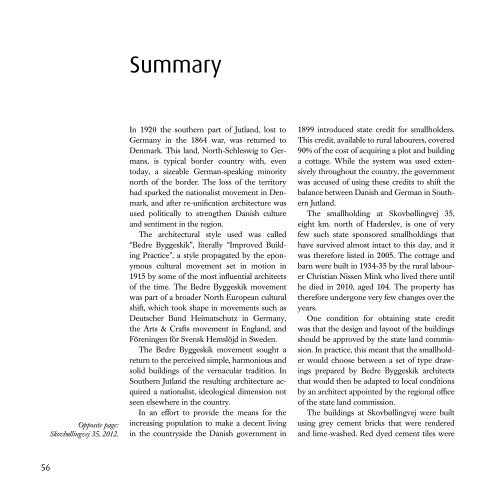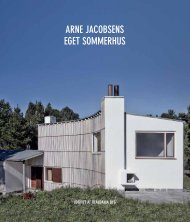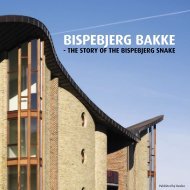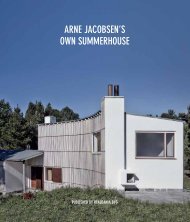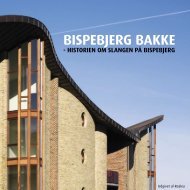Statshusmandsbrug - Realdania Byg
Statshusmandsbrug - Realdania Byg
Statshusmandsbrug - Realdania Byg
You also want an ePaper? Increase the reach of your titles
YUMPU automatically turns print PDFs into web optimized ePapers that Google loves.
56<br />
Opposite page:<br />
Skovbøllingvej 35, 2012.<br />
Summary<br />
In 1920 the southern part of Jutland, lost to<br />
Germany in the 1864 war, was returned to<br />
Denmark. This land, North-Schleswig to Germans,<br />
is typical border country with, even<br />
today, a sizeable German-speaking minority<br />
north of the border. The loss of the territory<br />
had sparked the nationalist movement in Denmark,<br />
and after re-unification architecture was<br />
used politically to strengthen Danish culture<br />
and sentiment in the region.<br />
The architectural style used was called<br />
“Bedre <strong>Byg</strong>geskik”, literally “Improved Building<br />
Practice”, a style propagated by the eponymous<br />
cultural movement set in motion in<br />
1915 by some of the most influential architects<br />
of the time. The Bedre <strong>Byg</strong>geskik movement<br />
was part of a broader North European cultural<br />
shift, which took shape in movements such as<br />
Deutscher Bund Heimatschutz in Germany,<br />
the Arts & Crafts movement in England, and<br />
Föreningen för Svensk Hemslöjd in Sweden.<br />
The Bedre <strong>Byg</strong>geskik movement sought a<br />
return to the perceived simple, harmonious and<br />
solid buildings of the vernacular tradition. In<br />
Southern Jutland the resulting architecture acquired<br />
a nationalist, ideological dimension not<br />
seen elsewhere in the country.<br />
In an effort to provide the means for the<br />
increasing population to make a decent living<br />
in the countryside the Danish government in<br />
1899 introduced state credit for smallholders.<br />
This credit, available to rural labourers, covered<br />
90% of the cost of acquiring a plot and building<br />
a cottage. While the system was used extensively<br />
throughout the country, the government<br />
was accused of using these credits to shift the<br />
balance between Danish and German in Southern<br />
Jutland.<br />
The smallholding at Skovbøllingvej 35,<br />
eight km. north of Haderslev, is one of very<br />
few such state sponsored smallholdings that<br />
have survived almost intact to this day, and it<br />
was therefore listed in 2005. The cottage and<br />
barn were built in 1934-35 by the rural labourer<br />
Christian Nissen Mink who lived there until<br />
he died in 2010, aged 104. The property has<br />
therefore undergone very few changes over the<br />
years.<br />
One condition for obtaining state credit<br />
was that the design and layout of the buildings<br />
should be approved by the state land commission.<br />
In practice, this meant that the smallholder<br />
would choose between a set of type drawings<br />
prepared by Bedre <strong>Byg</strong>geskik architects<br />
that would then be adapted to local conditions<br />
by an architect appointed by the regional office<br />
of the state land commission.<br />
The buildings at Skovbøllingvej were built<br />
using grey cement bricks that were rendered<br />
and lime-washed. Red dyed cement tiles were


